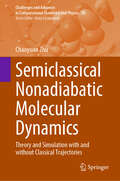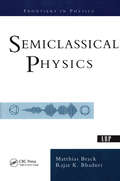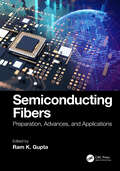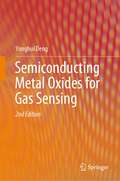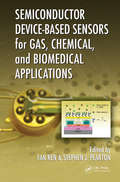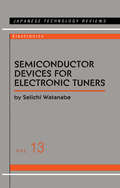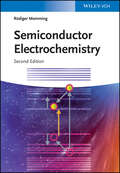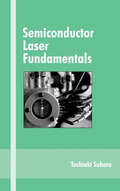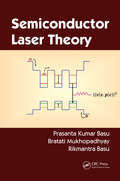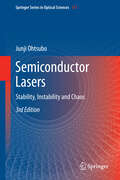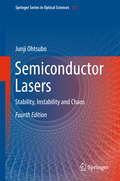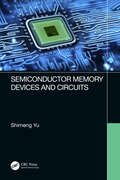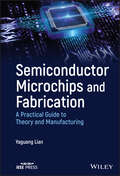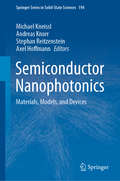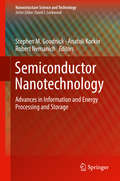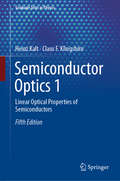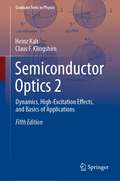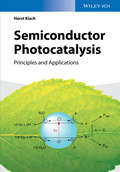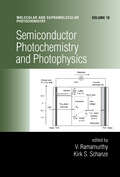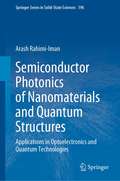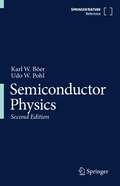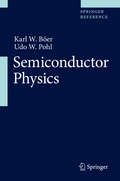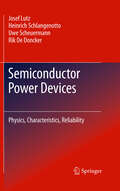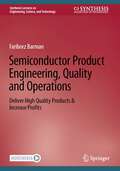- Table View
- List View
Semiclassical Nonadiabatic Molecular Dynamics: Theory and Simulation with and without Classical Trajectories (Challenges and Advances in Computational Chemistry and Physics #38)
by Chaoyuan ZhuThis book shows how to derive the simple and accurate semiclassical methods analytically and its applications to excited-state molecular dynamics and spectroscopy simulation with and without classical trajectories. It consists of eight chapters demonstrating interesting conical and intersystem-driven photochemical processes in complex systems targeting on large-scale ab initio direct nonadiabatic molecular dynamics. It also includes two chapters dealing with time-independent and time-dependent nonadiabatic molecular dynamics and clarifies the underline principle of Born–Oppenheimer approximation associated with coherence/decoherence quantum effects that have a wide range of applications in photochemistry and photophysics. This book is interesting and useful to a wide readership in the various fields of basic quantum chemistry and physics associated with large-scale excited-state simulation of nonadiabatic molecular dynamics and spectroscopy.
Semiclassical Physics (Frontiers in Physics)
by Matthias BrackSemiclassical Physics explores the fascinating and deep connection between classical motion and quantum fluctuations. The book conveys a way of describing quantum effects in a physical system using the periodic orbit theory of Gutzwiller, which focuses on the classical dynamics of the system. The authors seek to demonstrate its usefulness for understanding quantum fluctuations in interacting many-body systems, exhibiting the close link of the shorter classical periodic orbits with the partly resolved shell fluctuations. The extended Thomas-Fermi model is developed in detail and shown to describe the average properties of finite fermion systems in a self-consistent mean-field approach. The new, updated paperback edition includes: Basic introduction to semiclassical physics for the general reader Elementary derivation of the Gutzwiller trace formula for chaotic systems; thorough discussion of its extensions to mixed and integrable systems, uniform approximations, and diffractive corrections Unified presentation of extended Thomas-Fermi model, Wigner-Kirkwood expansion, Weyl and Euler-MacLaurin expansions, and Strutinsky averaging Relations of the Gutzwiller theory to the Selberg trace formula and Bogomolny's transfer-matrix method Applications to finite fermion systems in nuclear, atomic and condensed matter physics Analytical examples and educational problems with hints to their solution Appendices to facilitate further detailed study The book addresses graduate students with a basic knowledge of classical and quantum mechanics and scientists with an interest in semiclassical methods. The approach is informal, guided largely by simple solvable models and by practical applications to real physical phenomena.
Semiconducting Fibers: Preparation, Advances, and Applications
by Ram K GuptaSemiconducting Fibers: Preparation, Advances, and Applications is a comprehensive study of the properties and emerging applications of semiconducting fibers. These nanomaterials have unique optoelectronic properties: they are flexible, one-dimensional, and lightweight, and can grow in bulk, thin films, and nano-dimensions (0D, 1D, 2D, 3D). Written by experts from around the world, this book covers the fundamentals of semiconducting fibers, their fabrication, and emerging applications in electronics, optoelectronics, energy, and healthcare. Various approaches to fabricating semiconducting fibers, their characteristics, and the working principles of nano-dimensional devices are covered.Key features:• Expert scientists across the world present state-of-the-art progress on semiconducting fibers for emerging applications, including flexible and wearable electronics. • Provides details of novel methods and advanced technologies used in energy applications of semiconducting fibers.• Provides fundamentals of electrochemical behavior and their understanding of optoelectronics, photovoltaics, batteries, fuel cells, sensors, and supercapacitors.• Presents fabrication, characterization, and applications of semiconducting fibers for energy conversion and storage.This book will be a key resource for students, academics, and industry professionals interested in the fabrication, device technologies, and applications of semiconducting fibers.
Semiconducting Metal Oxides for Gas Sensing
by Yonghui DengThe second edition of this book focuses on the synthesis, design, and application of semiconducting metal oxides as gas sensing materials, including the gas sensing mechanism, and modification methods for sensing materials, while also providing a comprehensive introduction to semiconductor gas sensing devices. As an essential part of IoT (Internet of things), gas sensors have shown great significance and promising prospects. Therefore, studies on functional mesoporous metal oxides, one of the most important gas sensing materials based on their unique Knudsen diffusion behavior and tailored pore structure, have increasingly attracted attention from various disciplines. The book offers a valuable reference guide to metal oxide gas sensing materials for undergraduate and graduate students alike. It will also benefit all researchers who are involved in synthesis and gas sensing of metal oxides nanomaterials with relevant frontier theories and concepts. Engineers working on research and development of semiconductor gas sensors will also find some new ideas for sensor design.
Semiconductor Device-Based Sensors for Gas, Chemical, and Biomedical Applications
by Stephen J. Pearton Fan RenThis book provides a basic understanding of new developments on semiconductor-based sensors. Written for senior undergraduate and graduate students majoring in solid-state physics, electrical engineering, and materials science and engineering, this material is also relevant to researchers in the field of sensors for gas, chemical, bio, and medical applications. It presents original theory and experimental research, featuring numerous experts in the field who review progress in semiconductor and nano-material-based sensors and discuss the latest research regarding their applications. Fields addressed include: Si-MOS based sensors, nano-material based sensors, GaN-bsed sensor arrays for nano- and pico-fluidic systems, and InN based sensors.
Semiconductor Devices for Electronic Tuners (Japanese Technology Reviews Ser. #Sec. A)
by Seiichi WatanabeThis tract describes in detail the semiconductor components of the high-frequency front end-the electronic tuner-of televisions and VCRs. These high-frequency components substantially determine performance, including clarity of reception, and thus their quality is crucial to the success of electronic tuners. The semiconductor devices involved-voltage-variable capacitance diodes, band-switch diodes, dual-gate FETs, and others-are discussed in this book, as is their performance as mediators of tuning and amplification. Special emphasis is put on the analysis of distortion characteristics of tuning diodes and FETs, which are essential in providing tuners with high endurance against interfering signals. Design and fabrication processes well suited for mass production are also described. The content will be most informative not only to those involved in R&D and production of semiconductor devices, but also to high-frequency systems designers.
Semiconductor Electrochemistry
by Rüdiger MemmingProviding both an introduction and an up-to-date survey of the entire field, this text captivates the reader with its clear style and inspiring, yet solid presentation. <P><P>The significantly expanded second edition of this milestone work is supplemented by a completely new chapter on the hot topic of nanoparticles and includes the latest insights into the deposition of dye layers on semiconductor electrodes. <P>In his monograph, the acknowledged expert Professor Memming primarily addresses physical and electrochemists, but materials scientists, physicists, and engineers dealing with semiconductor technology and its applications will also benefit greatly from the contents.
Semiconductor Laser Fundamentals (Optical Science and Engineering)
by Toshiaki SuharaRanging from fundamental theoretical concepts to advanced device technologies, this reference/text explores the engineering, characteristics, and performance of specific semiconductor lasers. It defines key principles in electromagnetics, optoelectronics, and laser implementation for novel applications in optical communications, storage, processing
Semiconductor Laser Theory
by Prasanta Kumar Basu Bratati Mukhopadhyay Rikmantra BasuDeveloped from the authors' classroom-tested material, Semiconductor Laser Theory takes a semiclassical approach to teaching the principles, structure, and applications of semiconductor lasers. Designed for graduate students in physics, electrical engineering, and materials science, the text covers many recent developments, including diode lasers u
Semiconductor Lasers
by Junji OhtsuboThis third edition of "Semiconductor Lasers, Stability, Instability and Chaos" was significantly extended. In the previous edition, the dynamics and characteristics of chaos in semiconductor lasers after the introduction of the fundamental theory of laser chaos and chaotic dynamics induced by self-optical feedback and optical injection was discussed. Semiconductor lasers with new device structures, such as vertical-cavity surface-emitting lasers and broad-area semiconductor lasers, are interesting devices from the viewpoint of chaotic dynamics since they essentially involve chaotic dynamics even in their free-running oscillations. These topics are also treated with respect to the new developments in the current edition. Also the control of such instabilities and chaos control are critical issues for applications. Another interesting and important issue of semiconductor laser chaos in this third edition is chaos synchronization between two lasers and the application to optical secure communication. One of the new topics in this edition is fast physical number generation using chaotic semiconductor lasers for secure communication and development of chaos chips and their application. As other new important topics, the recent advance of new semiconductor laser structures is presented, such as quantum-dot semiconductor lasers, quantum-cascade semiconductor lasers, vertical-cavity surface-emitting lasers and physical random number generation with application to quantum key distribution. Stabilities, instabilities, and control of quantum-dot semiconductor lasers and quantum-cascade lasers are important topics in this field.
Semiconductor Lasers
by Junji OhtsuboThis third edition of "Semiconductor Lasers, Stability, Instability and Chaos" was significantly extended. In the previous edition, the dynamics and characteristics of chaos in semiconductor lasers after the introduction of the fundamental theory of laser chaos and chaotic dynamics induced by self-optical feedback and optical injection was discussed. Semiconductor lasers with new device structures, such as vertical-cavity surface-emitting lasers and broad-area semiconductor lasers, are interesting devices from the viewpoint of chaotic dynamics since they essentially involve chaotic dynamics even in their free-running oscillations. These topics are also treated with respect to the new developments in the current edition. Also the control of such instabilities and chaos control are critical issues for applications. Another interesting and important issue of semiconductor laser chaos in this third edition is chaos synchronization between two lasers and the application to optical secure communication. One of the new topics in this edition is fast physical number generation using chaotic semiconductor lasers for secure communication and development of chaos chips and their application. As other new important topics, the recent advance of new semiconductor laser structures is presented, such as quantum-dot semiconductor lasers, quantum-cascade semiconductor lasers, vertical-cavity surface-emitting lasers and physical random number generation with application to quantum key distribution. Stabilities, instabilities, and control of quantum-dot semiconductor lasers and quantum-cascade lasers are important topics in this field.
Semiconductor Memory Devices and Circuits
by Shimeng YuThis book covers semiconductor memory technologies from device bit-cell structures to memory array design with an emphasis on recent industry scaling trends and cutting-edge technologies. The first part of the book discusses the mainstream semiconductor memory technologies. The second part of the book discusses the emerging memory candidates that may have the potential to change the memory hierarchy, and surveys new applications of memory technologies for machine/deep learning applications. This book is intended for graduate students in electrical and computer engineering programs and researchers or industry professionals in semiconductors and microelectronics. Explains the design of basic memory bit-cells including 6-transistor SRAM, 1-transistor-1-capacitor DRAM, and floating gate/charge trap FLASH transistor Examines the design of the peripheral circuits including the sense amplifier and array-level organization for the memory array Examines industry trends of memory technologies such as FinFET based SRAM, High-Bandwidth-Memory (HBM), 3D NAND Flash, and 3D X-point array Discusses the prospects and challenges of emerging memory technologies such as PCM, RRAM, STT-MRAM/SOT-MRAM and FeRAM/FeFET Explores the new applications such as in-memory computing for AI hardware acceleration.
Semiconductor Microchips and Fabrication: A Practical Guide to Theory and Manufacturing
by Yaguang LianSemiconductor Microchips and Fabrication Advanced and highly illustrated guide to semiconductor manufacturing from an experienced industry insider Semiconductor Microchips and Fabrication is a practical yet advanced book on the theory, design, and manufacturing of semiconductor microchips that describes the process using the principles of physics and chemistry, fills in the knowledge gaps for professionals and students who need to know how manufacturing equipment works, and provides valuable suggestions and solutions to many problems that students or engineers often encounter in semiconductor processing, including useful experiment results to help in process work. The explanation of the semiconductor manufacturing process, and the equipment needed, is carried out based on the machines that are used in clean rooms over the world so readers understand how they can use the equipment to achieve their design and manufacturing ambitions. Combining theory with practice, all descriptions are carried out around the actual equipment and processes by way of a highly visual text, with illustrations including equipment pictures, manufacturing process schematics, and structures of semiconductor microchips. Sample topics covered in Semiconductor Microchips and Fabrication include: An introduction to basic concepts, such as impedance mismatch from plasma machines and theories, such as energy bands and Clausius-Clapeyron equation Basic knowledge used in semiconductor devices and manufacturing machines, including DC and AC circuits, electric fields, magnetic fields, resonant cavity, and the components used in the devices and machines Transistor and integrated circuits, including bipolar transistors, junction field effect transistors, and metal-semiconductor field effect transistors The main processes used in the manufacturing of microchips, including lithography, metallization, reactive-ion etching (RIE), plasma-enhanced chemical vapor deposition (PECVD), thermal oxidation and implantation, and more The skills in the design and problem solving of processes, such as how to design a dry etching recipe, and how to solve the micro-grass problems in Bosch process Through Semiconductor Microchips and Fabrication, readers can obtain the fundamental knowledge and skills of semiconductor manufacturing, which will help them better understand and use semiconductor technology to improve their product quality or project research. Before approaching this text, readers should have basic knowledge of physics, chemistry, and circuitry.
Semiconductor Nanophotonics: Materials, Models, and Devices (Springer Series in Solid-State Sciences #194)
by Andreas Knorr Michael Kneissl Axel Hoffmann Stephan ReitzensteinThis book provides a comprehensive overview of the state-of-the-art in the development of semiconductor nanostructures and nanophotonic devices. It covers epitaxial growth processes for GaAs- and GaN-based quantum dots and quantum wells, describes the fundamental optical, electronic, and vibronic properties of nanomaterials, and addresses the design and realization of various nanophotonic devices. These include energy-efficient and high-speed vertical cavity surface emitting lasers (VCSELs) and ultra-small metal-cavity nano-lasers for applications in multi-terabus systems; silicon photonic I/O engines based on the hybrid integration of VCSELs for highly efficient chip-to-chip communication; electrically driven quantum key systems based on q-bit and entangled photon emitters and their implementation in real information networks; and AlGaN-based deep UV laser diodes for applications in medical diagnostics, gas sensing, spectroscopy, and 3D printing. The experimental results are accompanied by reviews of theoretical models that describe nanophotonic devices and their base materials. The book details how optical transitions in the active materials, such as semiconductor quantum dots and quantum wells, can be described using a quantum approach to the dynamics of solid-state electrons under quantum confinement and their interaction with phonons, as well as their external pumping by electrical currents. With its broad and detailed scope, this book is indeed a cutting-edge resource for researchers, engineers and graduate-level students in the area of semiconductor materials, optoelectronic devices and photonic systems.
Semiconductor Nanotechnology: Advances in Information and Energy Processing and Storage (Nanostructure Science and Technology)
by Stephen M. Goodnick Anatoli Korkin Robert NemanichThis book presents research dedicated to solving scientific and technological problems in many areas of electronics, photonics and renewable energy. Energy and information are interconnected and are essential elements for the development of human society. Transmission, processing and storage of information requires energy consumption, while the efficient use and access to new energy sources requires new information (ideas and expertise) and the design of novel systems such as photovoltaic devices, fuel cells and batteries. Semiconductor physics creates the knowledge base for the development of information (computers, cell phones, etc.) and energy (photovoltaic) technologies. The exchange of ideas and expertise between these two technologies is critical and expands beyond semiconductors. Continued progress in information and renewable energy technologies requires miniaturization of devices and reduction of costs, energy and material consumption. The latest generation of electronic devices is now approaching nanometer scale dimensions, new materials are being introduced into electronics manufacturing at an unprecedented rate, and alternative technologies to mainstream CMOS are evolving. Nanotechnology is widely accepted as a source of potential solutions in securing future progress for information and energy technologies.Semiconductor Nanotechnology features chapters that cover the following areas: atomic scale materials design, bio- and molecular electronics, high frequency electronics, fabrication of nanodevices, magnetic materials and spintronics, materials and processes for integrated and subwave optoelectronics, nanoCMOS, new materials for FETs and other devices, nanoelectronics system architecture, nano optics and lasers, non-silicon materials and devices, chemical and biosensors, quantum effects in devices, nano science and technology applications in the development of novel solar energy devices, and fuel cells and batteries.
Semiconductor Optics 1: Linear Optical Properties of Semiconductors (Graduate Texts in Physics)
by Heinz Kalt Claus F. KlingshirnThis revised and updated edition of the well-received book by C. Klingshirn provides an introduction to and an overview of all aspects of semiconductor optics, from IR to visible and UV. It has been split into two volumes and rearranged to offer a clearer structure of the course content. Inserts on important experimental techniques as well as sections on topical research have been added to support research-oriented teaching and learning. Volume 1 provides an introduction to the linear optical properties of semiconductors. The mathematical treatment has been kept as elementary as possible to allow an intuitive approach to the understanding of results of semiconductor spectroscopy. Building on the phenomenological model of the Lorentz oscillator, the book describes the interaction of light with fundamental optical excitations in semiconductors (phonons, free carriers, excitons). It also offers a broad review of seminal research results augmented by concise descriptions of the relevant experimental techniques, e.g., Fourier transform IR spectroscopy, ellipsometry, modulation spectroscopy and spatially resolved methods, to name a few. Further, it picks up on hot topics in current research, like quantum structures, mono-layer semiconductors or Perovskites. The experimental aspects of semiconductor optics are complemented by an in-depth discussion of group theory in solid-state optics. Covering subjects ranging from physics to materials science and optoelectronics, this book provides a lively and comprehensive introduction to semiconductor optics. With over 120 problems, more than 480 figures, abstracts to each chapter, as well as boxed inserts and a detailed index, it is intended for use in graduate courses in physics and neighboring sciences like material science and electrical engineering. It is also a valuable reference resource for doctoral and advanced researchers.
Semiconductor Optics 2: Dynamics, High-Excitation Effects, and Basics of Applications (Graduate Texts in Physics)
by Heinz Kalt Claus F. KlingshirnThis book provides an introduction to and an overview of the multifaceted area of dynamics and nonlinearities related to optical excitations in semiconductors. It is a revised and significantly extended edition of the well-established book by C. Klingshirn split into two volumes and restructured to make it more concise. Inserts on important experimental techniques, reference to topical research and novel materials, as well as consideration of photonic applications support research-oriented teaching and learning. This book reviews nonlinear optical properties and many-body phenomena evoked by high densities of quasi-particles in semiconductors. Coherent dynamics and relaxation of optical excitations (carriers, excitons, electron–hole plasmas, etc.) as well as condensation phenomena are elucidated in these materials. A broad overview is provided of seminal research results augmented by detailed descriptions of the relevant experimental techniques, e.g., ultrafastspectroscopy, four-wave mixing, and the Hanbury-Brown and Twiss experiment. Offering a comprehensive introduction to hot topics in current research — polariton condensates, valley coherence, and single photons, to name a few, it also discusses applications of the described physical concepts in topical areas, such as quantum information, photonics, spintronics, and optoelectronics.Covering subjects ranging from physics to materials science and optoelectronics, the book provides a lively and comprehensive introduction to semiconductor optics beyond the linear regime.With many problems, chapter introductions, schematic depictions of physical phenomena, as well as boxed inserts and a detailed index, it is suitable for use in graduate courses in physics and neighboring sciences like material science and optical communication. It is also a valuable reference resource for doctoral and advanced researchers.
Semiconductor Photocatalysis
by Horst KischFocusing on the basic principles of semiconductor photocatalysis, this book also gives a brief introduction to photochemistry, photoelectrochemistry, and homogeneous photocatalysis. In addition, the author - one of the leading authorities in the field - presents important environmental and practical aspects. A valuable, one-stop source for all chemists, material scientists, and physicists working in this area, as well as novice researchers entering (semiconductor) photocatalysis.
Semiconductor Photochemistry And Photophysics/Volume Ten
by V. Ramamurthy Kirk S. SchanzeAnswering the need for information that could revolutionize the development of alternate solar energy sources and the reduction of atmospheric contaminants, Semiconductor Photochemistry and Photophysics reflects renewed interest inspired by the unique properties of nanocrystalline semiconductor particles. It provides a thorough overview and describ
Semiconductor Photonics of Nanomaterials and Quantum Structures: Applications in Optoelectronics and Quantum Technologies (Springer Series in Solid-State Sciences #196)
by Arash Rahimi-ImanThis book introduces the wider field of functional nanomaterials sciences, with a strong emphasis on semiconductor photonics. Whether you are studying photonic quantum devices or just interested in semiconductor nanomaterials and their benefits for optoelectronic applications, this book offers you a pedagogical overview of the relevant subjects along with topical reviews. The book discusses different yet complementary studies in the context of ongoing international research efforts, delivering examples from both fundamental and applied research to a broad readership. In addition, a hand-full of useful optical techniques for the characterization of semiconductor quantum structures and materials are addressed. Moreover, nanostructuring methods for the production of low-dimensional systems, which exhibit advantageous properties predominantly due to quantum effects, are summarized. Science and engineering professionals in the interdisciplinary domains of nanotechnology, photonics, materials sciences, and quantum physics can familiarize themselves with selected highlights with eyes towards photonic applications in the fields of two-dimensional materials research, light–matter interactions, and quantum technologies.
Semiconductor Physics
by Udo W. Pohl Karl W. BöerThis handbook gives a complete and detailed survey of the field of semiconductor physics. It addresses every fundamental principle, the most important research topics and results, as well as conventional and emerging new areas of application. Additionally it provides all essential reference material on crystalline bulk, low-dimensional, and amorphous semiconductors, including valuable data on their optical, transport, and dynamic properties.This updated and extended second edition includes essential coverage of rapidly advancing areas in semiconductor physics, such as topological insulators, quantum optics, magnetic nanostructures and spintronic systems. Richly illustrated and authored by a duo of internationally acclaimed experts in solar energy and semiconductor physics, this handbook delivers in-depth treatment of the field, reflecting a combined experience spanning several decades as both researchers and educators. Offering a unique perspective on many issues, Semiconductor Physics is an invaluable reference for physicists, materials scientists and engineers throughout academia and industry.
Semiconductor Physics: Introduction To Physical Principles (Graduate Texts in Physics #4)
by Udo W. Pohl Karl W. BöerThis handbook gives a complete survey of the important topics and results in semiconductor physics. It addresses every fundamental principle and most research topics and areas of application in the field of semiconductor physics. Comprehensive information is provided on crystalline bulk and low-dimensional as well as amporphous semiconductors, including optical, transport, and dynamic properties.
Semiconductor Power Devices
by Josef Lutz Heinrich Schlangenotto Rik De Doncker Uwe ScheuermannSemiconductor power devices are the heart of power electronics. They determine the performance of power converters and allow topologies with high efficiency. Semiconductor properties, pn-junctions and the physical phenomena for understanding power devices are discussed in depth. Working principles of state-of-the-art power diodes, thyristors, MOSFETs and IGBTs are explained in detail, as well as key aspects of semiconductor device production technology. In practice, not only the semiconductor, but also the thermal and mechanical properties of packaging and interconnection technologies are essential to predict device behavior in circuits. Wear and aging mechanisms are identified and reliability analyses principles are developed. Unique information on destructive mechanisms, including typical failure pictures, allows assessment of the ruggedness of power devices. Also parasitic effects, such as device induced electromagnetic interference problems, are addressed. The book concludes with modern power electronic system integration techniques and trends.
Semiconductor Product Engineering, Quality and Operations: Deliver High Quality Products & Increase Profits (Synthesis Lectures on Engineering, Science, and Technology)
by Fariborz BarmanThis book captures the author’s 35+ years of learning & experience in the semiconductor chip industry to provide a proven roadmap for successful, new product introduction process, tailored specifically to the semiconductor industry. The content includes a simplified process flow, success metrics, execution guidelines, checklists & calculators. The presentation is based on a product engineering centric “NPI hub” and the author guides readers through the complete process of semiconductor new product introduction, ensuring a successful plan execution.
Semiconductor Quantum Optics
by Mackillo Kira Stephan W. KochThe emerging field of semiconductor quantum optics combines semiconductor physics and quantum optics, with the aim of developing quantum devices with unprecedented performance. In this book researchers and graduate students alike will reach a new level of understanding to begin conducting state-of-the-art investigations. The book combines theoretical methods from quantum optics and solid-state physics to give a consistent microscopic description of light-matter- and many-body-interaction effects in low-dimensional semiconductor nanostructures. It develops the systematic theory needed to treat semiconductor quantum-optical effects, such as strong light-matter coupling, light-matter entanglement, squeezing, as well as quantum-optical semiconductor spectroscopy. Detailed derivations of key equations help readers learn the techniques and nearly 300 exercises help test their understanding of the materials covered. The book is accompanied by a website hosted by the authors, containing further discussions on topical issues, latest trends and publications on the field. The link can be found at www. cambridge. org/9780521875097.
